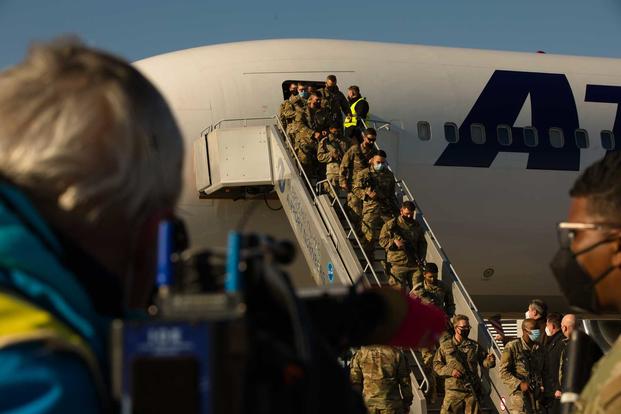As Russia marches on its warpath, encircling Ukrainian cities and bombing civilian buildings, the Pentagon has deployed some 12,000 troops to NATO member nations within spitting distance of Ukraine, a massing of infantry, aircraft and tanks not seen since the Cold War.
President Joe Biden has vowed those troops will not fight for Ukraine, instead framing their presence as a warning to Russian President Vladimir Putin that any advance past Ukraine's borders and into NATO territory would trigger direct conflict.
Nearly 5,000 troops with the 82nd Airborne Division serve as the largest component of U.S. combat power in Poland -- training with Polish forces and available to provide humanitarian assistance as more than one million Ukrainians have fled their country.
Read Next: F-18 Crashes and Explodes at Former South Carolina Gov's Family Plantation; Pilots Eject Safely
Next week, a group of 300 additional, mostly administrative, soldiers will deploy to Germany and Poland from V Corps, out of Fort Knox, Kentucky.
Another 7,000 troops, many of them from the 1st Armored Brigade Combat Team, 3rd Infantry Division, are also trickling into Europe. The rapid mobilization triggered the Army to draw from stocks of vehicles and armor already stationed on the continent.
That cache includes M1 Abrams tanks, Bradley fighting vehicles, Paladin artillery systems and other heavy combat vehicles and gear.
Last week, 800 paratroopers with the 173rd Airborne, based out of Vicenza, Italy, deployed to Latvia. In addition, the Pentagon moved at least eight F-35 Joint Strike Fighters from Germany closer to NATO's front line. At least 32 AH-64 Apache helicopters were also repositioned from Germany and Greece to the Baltic region and Poland.
Roughly 200 soldiers with the 101st Airborne Division, out of Fort Campbell, Kentucky, also deployed.
All of that firepower is meant to deter Putin from expanding his land grab beyond Ukraine, but is doing little to impact the humanitarian crisis that is unfolding.
At least 2,000 Ukrainian civilians have been killed so far, according to Ukraine's State Emergency Service. Independent verification of casualties during the conflict has been impossible.
The Russian Defence Ministry on Wednesday claimed 498 of its soldiers died in the first week of fighting. Even if the Kremlin's figures are artificially low, that would mark one of the deadliest periods of combat for Russian forces in decades. For comparison, 2,400 U.S. troops were killed in Afghanistan over 20 years.
As the war rages, NATO is continuing to bolster its front lines with thousands of troops from countries including France, the United Kingdom and Italy. Meanwhile, Ukraine is being armed with missiles and other equipment to stave off the Russian advance, an arming mission being organized by U.S. European Command. So far, Ukrainian forces have managed to stall much of the Russian advance, holding on to many of the country's largest cities.
In addition to the American mobilizations, 8,500 troops in the U.S. are on alert to deploy in case more forces are needed. And other units, such as the 1st Armored Brigade Combat Team, 1st Infantry Division, were already in countries such as Poland, Latvia and Romania on pre-planned missions.
The National Guard makes up a major chunk of the force on those pre-planned missions, further boosting NATO's combat power. Before the invasion, 160 soldiers with the Florida National Guard were in Ukraine, but were eventually pulled out to avoid a confrontation with Russian forces.
These National Guard missions include California's 1st Battalion, 185th Infantry Regiment; 200 troops from Washington state's 2nd Battalion, 146th Field Artillery Regiment, and 898th Brigade Engineer Battalion; and 100 soldiers from Oregon's 1st Squadron, 82nd Cavalry Regiment.
-- Steve Beynon can be reached at Steve.Beynon@military.com. Follow him on Twitter @StevenBeynon.
Related: Global Weapons Pipeline into Ukraine Is Being Managed by US European Command














